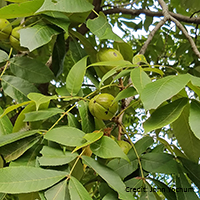What shellbark hickory looks like
Size and shape
- Reaches up to 30 metres high.
- Trunk reaches up to 90 centimetres in diameter.
Leaves
- Compound leaf (25 to 30 centimetres long).
- Composed of 7 finely toothed leaflets.
- Dark yellow to green.
Bark
- Dark grey.
- Separates into shaggy plates with age.
Flowers
- Male flowers grow as 3-branched catkins.
- Female flowers grow as clusters at the end of new shoots.
Fruit
- Globular (5 to 7 centimetres)
- Nuts are covered in a husk and a hard shell.
- Nuts are edible and sweet.
Where shellbark hickory is found
Shellbark hickory is not common in Canada but can be found scattered across Southern Ontario north of Lake Erie.
What you need to know to grow shellbark hickory
- Moisture: grows best in moist soils but is drought tolerant.
- Soil: grows best in loam, can grow in sand and clay.
- Shade: grows best in full sun.
- Caution: Shellbark hickory trees have a long taproot, making them difficult to transplant.
Benefits and uses of shellbark hickory
Wildlife benefits
Shellbark hickory leaves are eaten by browsers, such as white-tailed deer. The nuts are a food source for many animals, including:
- foxes
- rabbits
- squirrels
- wild turkey
Commercial uses
Hickory trees have dense and strong wood. Shellbark hickory wood has been used to make gunstocks, ramrods (for cleaning guns) and tool handles.
Shellbark hickory charcoal can be used to smoke meats, giving them a classic ‘hickory’ flavour.
Fun facts about shellbark hickory
- Shellbark hickory trees can live up to 200 years.
- Shellbark hickory has larger nuts than other hickories.
Updated: October 10, 2023
Published: October 10, 2023




